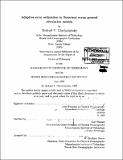| dc.contributor.advisor | Carl Wunsch. | en_US |
| dc.contributor.author | Chechelnitsky, Michael Y. (Michael Yurievich), 1972- | en_US |
| dc.contributor.other | Woods Hole Oceanographic Institution. | en_US |
| dc.date.accessioned | 2010-09-13T14:05:19Z | |
| dc.date.available | 2010-09-13T14:05:19Z | |
| dc.date.copyright | 1999 | en_US |
| dc.date.issued | 1999 | en_US |
| dc.identifier.uri | http://hdl.handle.net/1721.1/58516 | |
| dc.description | Thesis (Ph. D.)--Joint Program in Physical Oceanography (Massachusetts Institute of Technology, Dept. of Earth, Atmospheric, and Planetary Sciences; and the Woods Hole Oceanographic Institution), 1999. | en_US |
| dc.description | Includes bibliographical references (p. 206-211). | en_US |
| dc.description.abstract | Data assimilation methods, such as the Kalman filter, are routinely used in oceanography. The statistics of the model and measurement errors need to be specified a priori. In this study we address the problem of estimating model and measurement error statistics from observations. We start by testing the Myers and Tapley (1976, MT) method of adaptive error estimation with low-dimensional models. We then apply the MT method in the North Pacific (5°-60° N, 132°-252° E) to TOPEX/POSEIDON sea level anomaly data, acoustic tomography data from the ATOC project, and the MIT General Circulation Model (GCM). A reduced state linear model that describes large scale internal (baroclinic) error dynamics is used. The MT method, closely related to the maximum likelihood methods of Belanger (1974) and Dee (1995), is shown to be sensitive to the initial guess for the error statistics and the type of observations. It does not provide information about the uncertainty of the estimates nor does it provide information about which structures of the error statistics can be estimated and which cannot. A new off-line approach is developed, the covariance matching approach (CMA), where covariance matrices of model-data residuals are "matched" to their theoretical expectations using familiar least squares methods. This method uses observations directly instead of the innovations sequence and is shown to be related to the MT method and the method of Fu et al. (1993). The CMA is both a powerful diagnostic tool for addressing theoretical questions and an efficient estimator for real data assimilation studies. It can be extended to estimate other statistics of the errors, trends, annual cycles, etc. Twin experiments using the same linearized MIT GCM suggest that altimetric data are ill-suited to the estimation of internal GCM errors, but that such estimates can in theory be obtained using acoustic data. After removal of trends and annual cycles, the low frequency /wavenumber (periods> 2 months, wavelengths> 16°) TOPEX/POSEIDON sea level anomaly is of the order 6 cm2. The GCM explains about 40% of that variance. By covariance matching, it is estimated that 60% of the GCM-TOPEX/POSEIDON residual variance is consistent with the reduced state linear model. The CMA is then applied to TOPEX/POSEIDON sea level anomaly data and a linearization of a global GFDL GCM. The linearization, done in Fukumori et al.(1999), uses two vertical mode, the barotropic and the first baroclinic modes. We show that the CMA method can be used with a global model and a global data set, and that the estimates of the error statistics are robust. We show that the fraction of the GCMTOPEX/ POSEIDON residual variance explained by the model error is larger than that derived in Fukumori et al.(1999) with the method of Fu et al.(1993). Most of the model error is explained by the barotropic mode. However, we find that impact of the change in the error statistics on the data assimilation estimates is very small. This is explained by the large representation error, i.e. the dominance of the mesoscale eddies in the TIP signal, which are not part of the 20 by 10 GCM. Therefore, the impact of the observations on the assimilation is very small even after the adjustment of the error statistics. This work demonstrates that simultaneous estimation of the model and measurement error statistics for data assimilation with global ocean data sets and linearized GCMs is possible. However, the error covariance estimation problem is in general highly underdetermined, much more so than the state estimation problem. In other words there exist a very large number of statistical models that can be made consistent with the available data. Therefore, methods for obtaining quantitative error estimates, powerful though they may be, cannot replace physical insight. Used in the right context, as a tool for guiding the choice of a small number of model error parameters, covariance matching can be a useful addition to the repertory of tools available to oceanographers. | en_US |
| dc.description.statementofresponsibility | by Michael Y. Chechelnitsky. | en_US |
| dc.format.extent | 177 p. | en_US |
| dc.language.iso | eng | en_US |
| dc.publisher | Massachusetts Institute of Technology | en_US |
| dc.rights | M.I.T. theses are protected by
copyright. They may be viewed from this source for any purpose, but
reproduction or distribution in any format is prohibited without written
permission. See provided URL for inquiries about permission. | en_US |
| dc.rights.uri | http://dspace.mit.edu/handle/1721.1/7582 | en_US |
| dc.subject | Earth, Atmospheric, and Planetary Sciences. | en_US |
| dc.subject | Joint Program in Physical Oceanography. | en_US |
| dc.subject | Woods Hole Oceanographic Institution. | en_US |
| dc.subject.lcc | GC1 | en_US |
| dc.title | Adaptive error estimation in linearized ocean general circulation models | en_US |
| dc.type | Thesis | en_US |
| dc.description.degree | Ph.D. | en_US |
| dc.contributor.department | Massachusetts Institute of Technology. Department of Earth, Atmospheric, and Planetary Sciences | en_US |
| dc.contributor.department | Joint Program in Physical Oceanography | en_US |
| dc.contributor.department | Woods Hole Oceanographic Institution | en_US |
| dc.identifier.oclc | 43855903 | en_US |
